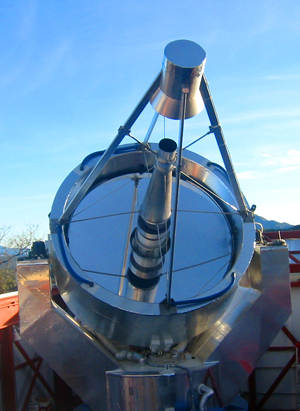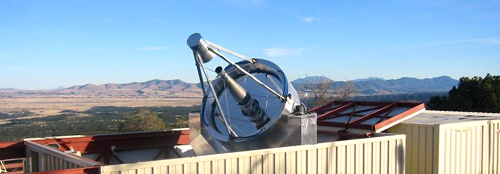T13 2.0 meter AST

Observing Program
The T13 2.0m Automatic Spectroscopic Telescope (AST) and fiber-fed echelle spectrograph began routine operations in 2003 at Fairborn Observatory. Funding for the construction and operation the AST has been provided by NASA, NSF, and Tennessee State University.
The AST is intended to support observations made with NASA's satellite
observatories, both by astronomers inside and outside the Center of
Excellence. Plans for initial research include searches for magnetic
activity cycles in cool stars, determination of the distributions of
spots and active regions on cool chromospherically active stars,
determinations of accurate three-dimensional orbits of moderate- and
long-period binary systems (in collaboration with Georgia State) to map out
the giant branch and lower main sequence, the determination of evolution of
lithium abundance throughout the HR diagramme, determination of properties of
close binaries precisely enough to determine generic relationships among
various classes of such stars, and other collaborative research designed
to determine the sources of stellar winds and chromospheric heating,
to understand mass exchange in cataclysmic variables and Algol binaries, and
to make more precise Doppler images of chromospherically active stars.
Description
The telescope is a classical Cassegrain with an 81-inch f/1.5 primary mirror and an 11-inch secondary giving a f/8 optical system with its focus between the two mirrors, 18 inches in front of the vertex of the primary mirror. The primary mirror is a surplus Cervit mirror made for the Air Force around 1970, which came with an existing mirror cell made of aluminum. The optical system is carried in an alt-azimuth mount designed at TSU. It consists of the existing mirror cell supported by an aluminum fork carried on three hydrostatic bearings supported on a drum-shaped base. The two motions of the telescope are provided by conventional friction drives, while the secondary mirror is carried by a light-weight quadrapod structure. Moving weight of this telescope is about 13,000 lbs, and all the drive electronics are mounted on the fork to reduce problems with control cables.
The instrument is a fiber-fed spectrograph with three modes: 1) a standard cross-dispersed echelle (R=34,000), 2) a higher-dispersion mode (R=90,000) of the echelle, and 3) a low-dispersion mode (R=2000) provided by using the cross disperser alone.
The telescope is housed in an enclosure with a roll-off upper section, having a footprint of about 18 by 23 ft and total height of about 20 ft. The spectrograph is mounted in a separate enclosure to the south of the telescope enclosure.
Control of the telescope is provided by two computers, a telescope control computer, which runs the drive servos and the acquisition/guiding camera, and an instrument computer that controls the spectrograph, including its CCD camera, runs the local scheduling programs, controls the enclosure, and communicates with the outside world.
The mirrors for this telescope have been provided by Torus Optics
of Iowa City, IA. Fabrication of the major parts of the mount was done
by Lockheed-Martin Energy Systems of Oak Ridge, TN, (the Y12 plant at Oak
Ridge National Laboratory) with machining of other parts of the mount by
Tennessee manufacturers such as Marlyn E. Krebs, Schmiede Corp., Hamilton
Machine Co., and J. W. McDougal.
For More Information
See T13 2.0~m AST
